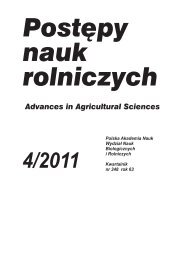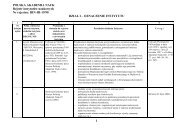Postepy nauk rolniczych - Instytucja Naukowa - Polska Akademia ...
Postepy nauk rolniczych - Instytucja Naukowa - Polska Akademia ...
Postepy nauk rolniczych - Instytucja Naukowa - Polska Akademia ...
Create successful ePaper yourself
Turn your PDF publications into a flip-book with our unique Google optimized e-Paper software.
Roœliny dziko rosn¹ce … 29<br />
[26] Kaliciak A., Syller J. 2009. New hosts of Potato virus Y (PVY) among common wild plants in Europe. Eur. J.<br />
Plant Pathol. 124: 707–713.<br />
[27] Kazinczi G., Horvath J., Takacs A.P., Gaborjanyi R., Beres I. 2004. Experimental and natural weed host-virus<br />
relations. Commun. Agric. Appl. Biol. Sci. 69: 53–60.<br />
[28] Kerlan C. 2009. Potato viruses. W: Desk Encyclopedia of Plant and Fungal Virology. Mahy B.W.J., van<br />
Regenmortel M.H.V. (red.). Academic Press: 458–471.<br />
[29] Kerlan C., Tribodet M., Glais L., Guillet M. 1999. Variability of potato virus Y in potato crops in France. J.<br />
Phytopathol. 147: 643–651.<br />
[30] Kostiw M., Sekrecka D. 2009. Infection of potato tubers of chosen cultivars by Y, M, S and potato leafroll<br />
viruses in ecological crops in the north of Poland in years 2006–2008. Phytopathologia 51: 45–52.<br />
[31] Loebenstein G., Thottappilly G. 2003. Virus and virus-like diseases of major crops in developing countries.<br />
Kluwer Academic Publishers, Dordrecht: 300 ss.<br />
[32] Malpica J.M., Sacristán S., Fraile A., Garcia-Arenal F. 2006. Association and host selectivity in multi-host<br />
pathogens. PLoS ONE 1(1): e41.<br />
[33] Mertelik J., Mokrá V. 1998. Tomato spotted wilt virus in ornamental plants, vegetables and weeds in the Czech<br />
Republic. Acta Virol. 42: 347–351.<br />
[34] Moreno A., de Blas C., Biurrun R., Nebreda M., Palacios I., Duque M., Fereres A. 2004. The incidence and<br />
distribution of viruses infecting lettuce, cultivated Brassica and associated natural vegetation in Spain. Ann.<br />
Appl. Biol. 144: 339–346.<br />
[35] Norris R.F., Kogan M. 2005. Ecology of interactions between weeds and arthropods. Ann. Rev. Entomol. 50:<br />
479–503.<br />
[36] Orosz Sz., Juhász M., Tôkés G., Tóth F. 2008. Occurrence of Thrips tabaci larvae on TSWV host weeds in the<br />
surroundings of sweet pepper greenhouses. Acta Phytopathol. Entomol. Hung. 43: 329–336.<br />
[37] Pappu H.R., Jones R.A.C., Jain R.K. 2009. Global status of tospovirus epidemics in diverse cropping systems:<br />
Success achieved and challenges ahead. Virus Res. 141: 219–236.<br />
[38] Parrella G., Gognalons P., Gebre-Selassiè K., Vovlas C., Marchoux G. 2003. An update of the host range of<br />
Tomato spotted wilt virus. J. Plant Pathol. 85: 227–264.<br />
[39] Radcliffe E.B., Ragsdale D.W. 2002. Aphid-transmitted potato viruses: The importance of understanding<br />
vector biology. Am. J. Potato Res. 79: 353–386.<br />
[40] Rahman M.S., Akanda A.M. 2010. Effect of PLRV infected seed tuber on disease incidence, plant growth and<br />
yield parameters of potato. Bangladesh J. Agril. Res. 35: 359–366.<br />
[41] Sharma P.D. 2006. Plant Pathology. Alpha Science International, Oxford: 550 ss.<br />
[42] Shukla D.D., Ward C.W., Brunt A.A. 1994. The Potyviridae. Cambridge University Press, Cambridge: 516 ss.<br />
[43] Sierka W. 2008. Wciornastki (Insecta: Thysanoptera) i ich znaczenie w uprawach ziemniaka. Ziemn. Pol. 2: 45–46.<br />
[44] Solomon-Blackburn R.M., Barker H. 2001. Breeding virus resistant potatoes (Solanum tuberosum): a review of<br />
traditional and molecular approaches. Heredity 86: 17–35.<br />
[45] Srinivasan R., Alvarez J.M. 2008. Hairy nightshade as a potential Potato leafroll virus (Luteoviridae:<br />
Polerovirus) inoculums source in Pacific Northwest potato ecosystems. Phytopathology 98: 985–991.<br />
[46] Srinivasan R., Alvarez J.M., Bosque-Pérez N.A., Eigenbrode S.D., Novy R.G. 2008. Effect of an alternate weed<br />
host, hairy nightshade, Solanum sarrachoides, on the biology of the two most important potato leafroll virus<br />
(Luteoviridae: Polerovirus) vectors, Myzus persicae and Macrosiphum euphorbiae (Aphididae: Homoptera).<br />
Environ. Entomol. 37: 592–600.<br />
[47] Syller J. 2000. Molekularne podstawy zdolnoœci przenoszenia wirusów roœlinnych przez owady. Post. Mikrobiol.<br />
39: 224–238.<br />
[48] Thomas P.E., Hassan S. 2002. First report of twenty-two new hosts of Potato leafroll virus. Plant Dis. 86: 561.<br />
[49] Wilson C.R. 2001. Resistance to infection and translocation of Tomato spotted wilt virus in potatoes. Plant<br />
Pathol. 50: 402–410.<br />
[50] Wisler G.C., Norris R.F. 2005. Interactions between weeds and cultivated plants as related to management of<br />
plant pathogens. Weed Sci. 53: 914–917.<br />
[51] Xu H., D’Aubin J., Nie J. 2010. Genomic variability in Potato virus M and the development of RT-PCR and<br />
RFLP procedures for the detection of this virus in seed potatoes. Virol. J. 7: 25.<br />
[52] Zitter T.A. 2001. Vegetable MD Online. Vegetable Crops: A checklist of major weeds and crops as natural hosts<br />
for plant viruses in the Northeast. Version: November 2001.<br />
«http://vegetablemdonline.ppath.cornell.edu/Tables/WeedHostTable.html»

















